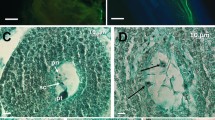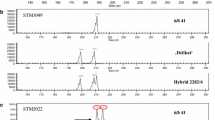Summary
Asymmetric somatic hybrid plants were obtained by a modified PEG/DMSO fusion procedure between protoplasts derived from suspension cells of an interspecific tomato hybrid, Lycopersicon esculentum x L. pennellii, and mesophyll protoplasts of Solanum melongena, eggplant. The tomato hybrid was previously transformed with Agrobacterium tumefaciens and contained the kanamycin-resistance marker gene. Prior to fusion, the donor protoplasts of the tomato hybrid were gamma irradiated at 9.0 krad. Thus, non-division of irradiated tomato hybrid protoplasts coupled with kanamycin sensitivity of eggplant enabled selection of somatic cell hybrids. Forty-nine calli selected post-fusion regenerated leaf-like structures in the presence of 50 mg/l kanamycin. However, only four of the 49 calli regenerated intact shoots which rooted in the presence of 50 mg/l kanamycin and were later transferred to the greenhouse. Analysis of phosphoglucoisomerase and peroxidase isozymes, and Southern hybridization with a nuclear-specific pea 45 S ribosomal RNA gene confirmed somatic hybrid status. Cytology revealed that the four hybrid plants had chromosome numbers of 45, 60, 42 and 57, respectively; they were all sterile.
Similar content being viewed by others
References
Bates GW, Hasenkampf CA, Contolini CL, Piastuch WC (1987) Theor Appl Genet 74:718–726
Chyi Y-S, Jorgensen RA, Goldstein D, Tanksley SD, Loaiza-Figueroa F (1986) Molec Gen Genet 204:64–69
Dudits D, Maroy E, Praznovszky T, Olah Z, Gyorgyey J, Cella R (1987) Proc Nat Acad Sci (USA) 84:8434–8438
Feher A, Preiszner J, Litkey Z, Csanadi, Dudits D (1992) Theor Appl Genet 84:880–890
Ferreira DI, Zelcer A (1989) Int Rev Cyto 115:1–65
Frearson EM, Power JB, Cocking EC (1973) Dev Biol 33:130–137
Gleddie S, Keller WA, Setterfield G (1986) Theor Appl Genet 71:613–621
Gupta PP, Schieder O, Gupta M (1984) Molec Gen Genet 197:30–35
Guri A, Izhar S (1984) Plant Cell Rep 3:247–249
Guri A, Sink KC (1988) Theor Appl Genet 76:490–496
Guri A, Dunbar LJ, Sink KC (1991) Plant Cell Rep 10:76–80
Guri A, Levi A, Sink KC (1988) Molec Gen Genet 212:191–198
Guri A, Volokita M, Sink KC (1987) Plant Cell Rep 6:302–304
Hinnisdaels S, Bariller L, Mouras A, Sidorov V, Del-Favero J, Veuskens J, Negrutiu I, Jacobs M (1991) Theor Appl Genet 82:609–614
Kao KN, Michayluk MR (1981) In Vitro 17:645–648
Lartin PJ, Spindler LH, Banks PM (1990) Proc VII Int Congr Plant Tissue Cell Culture, pp 163–168
McCabe PF, Dunbar LJ, Guri A, Sink KC (1993) Theor Appl Genet 86:377–382
Melzer JM, O'Connell MA (1992) Theor Appl Genet 83:337–344
Murashige T, Skoog F (1962) Physiol Plant 15:473–497
O'Connell MA, Hanson MR (1985) Theor Appl Genet 70:1–12
Puite KJ, Schaart JG (1993) Theor Appl Genet 86:237–244
Rogers SO, Bendich A (1988) Plant Mol Biol Mannual A6:1–16
Sambrook J, Fritsch EF, Manniatis T (1989) Molecular Cloning: A laboratory mannual. Cold Spring Harbor Press. Cold Spring Harbor. pp 9.31–9.57
Soltis D, Haufler CH, Darrow DC, Gastony GJ (1983) American Fern J 73:9–27
Somers DA, Narayanan KR, Kleinhofs A, Cooper-Blands, Cooking EC (1986) Molec Gen Genet 204:296–301
Uchimaya H, Murashige T (1974) Plant Physiol 54:936–944
Wijbrandi J, Zabel P, Koornneef M (1990) Molec Gen Genet 222:270–277
Wolters AMA, Schoenmakers HCH, van der Meulen-Muisers JJM, van der Knapp E, Derks FHM, Koornneef M, Zelcer A (1991) Theor Appl Genet 83:225–232
Author information
Authors and Affiliations
Additional information
Communicated by J. M. Widholm
Rights and permissions
About this article
Cite this article
Liu, K.B., Li, YM. & Sink, K.C. Asymmetric somatic hybrid plants between an interspecific Lycopersicon hybrid and Solanum melongena . Plant Cell Reports 14, 652–656 (1995). https://doi.org/10.1007/BF00232732
Received:
Revised:
Published:
Issue Date:
DOI: https://doi.org/10.1007/BF00232732




